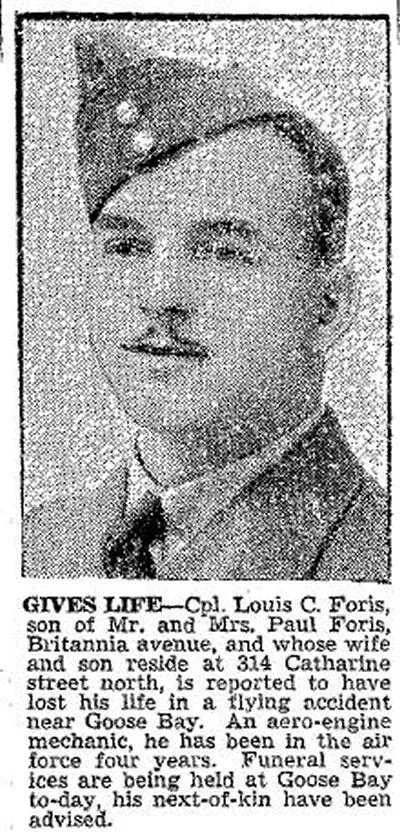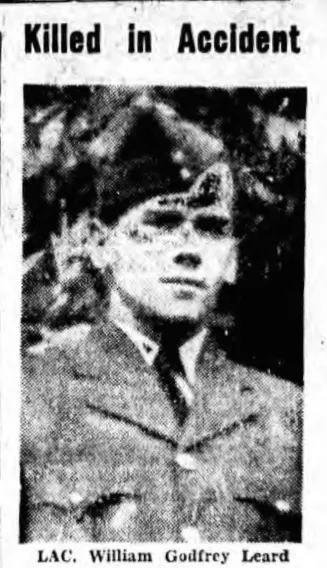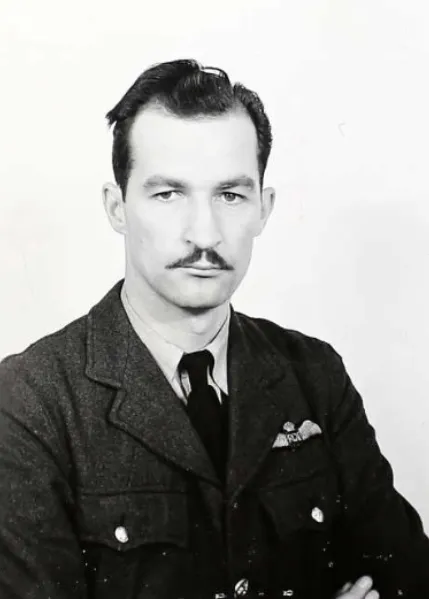Hume, Donald William (Flying Officer)
Killed in Action 1944-July-06
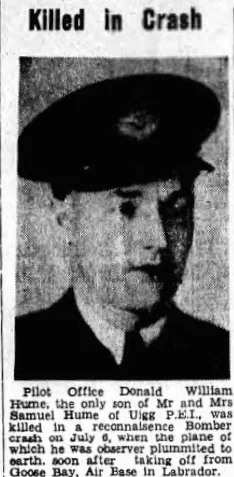

Birth Date: 1921-February-02
Born: Wood Islands, Prince Edward Island
Parents: Son of Samuel and Edith Hume, of Kinross, Prince Edward Island; husband of Katherine M. Hume, of Dartmouth, Nova Scotia.
Spouse: Husband of Katherine M. Hume, of Dartmouth, Nova Scotia.
Home: Kinross, Prince Edward Island
Enlistment: Moncton, New Brunswick
Enlistment Date: 1942-June-08
Service
RCAF
Unit
145 Sqn- Squadron
Furor Non Sine Frenis Fury with balance
Base
RCAF Stn. Dartmouth N S
Rank
Flying Officer
Position
Navigator
Service Numbers
J/37490
Crew or Other Personnel
Ventura 2171
Accident Card - Lockheed Ventura G.R. Mk. V serial:2171
This accident involved 1 aircraft on 1944-July-06. Ventura GRV s/n 2171.
This accident involved 11 people. Bell HH, Cole CNT, Duquette MK, Foris LS, Harris WA, Hume DW, Leard WG, St Louis LC, Stephenson HA, Tanner JC, Wood MS
This accident had 11 fatalities. Flying Officer Donald William Hume RCAF Killed in Action service no:J/37490 Ventura 2171, Sergeant Myles Edward Duquette RCAF Killed in Action service no:R/111463 Ventura 2171, Corporal Clarence Nathon Cole RCAF Killed in Action service no:R/65379 Ventura 2171, Leading Aircraftman Henry Hedley Bell RCAF Killed in Action service no:R/183298 Ventura 2171, Leading Aircraftman Lionel Charles St Louis RCAF Killed in Action service no:R/200411 Ventura 2171, Pilot Officer John Charles Tanner RCAF Killed in Action service no:J/43174 Ventura 2171, Warrant Officer 1 Melville Stanley Wood RCAF Killed in Action service no:R/93134 Ventura 2171, Leading Aircraftman Harold Archibald Stephenson RCAF Killed in Action service no:R/127526 Ventura 2171, Corporal Louis Charles Foris RCAF Killed in Action service no:R/64254 Ventura 2171, Flying Officer William Arthur Harris RCAF Killed in Action service no:J/38593 Ventura 2171, Leading Aircraftman William Godfrey Leard RCAF Killed in Action service no:R/174974 Ventura 2171
Ventura serial: 2171
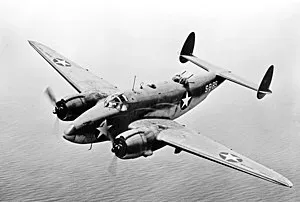
A Lockheed PV-1 Ventura
The Lockheed Ventura is a twin-engine medium bomber and patrol bomber of World War II.
The Ventura first entered combat in Europe as a bomber with the RAF in late 1942. Designated PV-1 by the United States Navy (US Navy), it entered combat in 1943 in the Pacific. The bomber was also used by the United States Army Air Forces (USAAF), which designated it the Lockheed B-34 (Lexington) and B-37 as a trainer. British Commonwealth forces also used it in several guises, including antishipping and antisubmarine search and attack.
The Ventura was developed from the Lockheed Model 18 Lodestar transport, as a replacement for the Lockheed Hudson bombers then in service with the Royal Air Force. Used in daylight attacks against occupied Europe, they proved to have weaknesses and were removed from bomber duty and some used for patrols by Coastal Command.
At the start of the war, Lockheed proposed military conversions of the Lodestar for the RAF as replacement for the Hudson reconnaissance aircraft and the Bristol Blenheim bomber. The first British order was placed in February 1940 for 25 Model 32 as bombers. This was followed by an order for 300 Model 37 with Double Wasp engines, then for a further 375 later in 1940. Lockheed needed more production capacity and nearby Vega Aircraft Corporation was contracted for building the Ventura.
The Ventura was very similar to its predecessor, the Lockheed Hudson. The primary difference was not in layout; rather, the Ventura was larger, heavier, and used more powerful engines than the Hudson. The RAF ordered 188 Venturas in February 1940, which were delivered from mid-1942. Venturas were initially used for daylight raids on occupied Europe but, like some other RAF bombers, they proved too vulnerable without fighter escort, which was difficult to provide for long-range missions. Venturas were replaced by the faster de Havilland Mosquito. The Venturas were transferred to patrol duties with Coastal Command as the Mosquito replaced them in bomber squadrons; 30 went to the Royal Canadian Air Force (RCAF) and some to the South African Air Force (SAAF). The RAF placed an order for 487 Ventura Mark IIs but many of these were diverted to the USAAF, which placed its own order for 200 Ventura Mark IIA as the B-34 Lexington, later renamed RB-34.
A total of 157 Ventura G.R. Mk. Vs were used operationally by the RCAF from 16 June 1942 to 18 April 1947 in the home defence coastal patrol role in both Eastern and Western Air Command. They were flown by 8, 113, 115, 145, and 149 Squadrons. A further 21 Ventura Mk. Is and 108 Ventura Mk. IIs were used in a training role at 1 Central Flying School, Trenton, Ontario, and at RCAF Station Pennfield Ridge, New Brunswick (RAF No. 34 Operational Training Unit) as part of the BCATP. A total of 21 Mk. Is, 108 Mk. IIs, and 157 G.R. Mk. Vs were in service during this period for a total of 286 aircraft. Wikipedia
Aircraft Images
Ventura 2171
Ventura G.R. Mk. V 2171
Ex-USN, BuNo 33236. Served with No. 145 (BR) Squadron at RCAF Stn Dartmouth, NS in 1943/44. Coded "Y". Struck off, after a Cat "A" crash on 9 Jul 1944 at Goose Bay, NF. The heavily loaded a/c crashed and burned on take-off. Five crew members killed. included Flying Officer W.A. Harris (WAG, Pilot Officer J.C. Tanner (Pilot), Flying Officer D.W. Hume (Nav), Warrant Officer M.S. Wood (WAG) and Leading Aircraftman H.A. Stephenson Six passengers including LAC's H.H. Bell, L.C. St. Louis, Cpls C.W.T. Cole, L.C. Forie and Flight Sergeant M.K. Duquette were also killed. The accident was attributed to pilot error. The maximum crew / passenger load should have been limited to 8 or 9.1943-05-29 Taken on Strength 2019-08-20
1944-July-06 Accident: 145 Squadron Loc: Goose Bay Labrador Names: Bell | Cole | Duquette | Foris | Harris | Hume | Leard | St Louis | Stephenson | Tanner | Wood
1944-10-11 Struck off Strength after Category A crash 2022-01-21


